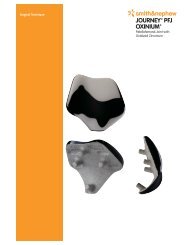Uni- Condylar Knee Surgical Technique - Yorkshire Joint ...
Uni- Condylar Knee Surgical Technique - Yorkshire Joint ...
Uni- Condylar Knee Surgical Technique - Yorkshire Joint ...
You also want an ePaper? Increase the reach of your titles
YUMPU automatically turns print PDFs into web optimized ePapers that Google loves.
Cement <strong>Technique</strong><br />
Metal-backed tibial component<br />
Engage the rounded end of the tibial trial of<br />
appropriate size and thickness with the tibial<br />
tray. Apply a layer of cement to the backside of<br />
the tray.<br />
Stabilising the trial and tray with a finger,<br />
introduce the tibial prosthesis at a 45° angle,<br />
engaging the most posterior aspect of the tibial<br />
keel to the prepared channel first (Figure 38).<br />
Lower the anterior of the prosthesis into position.<br />
This sequence promotes the flow of cement from<br />
posterior to anterior as the prosthesis is seated.<br />
Use a mallet and the C–arm to complete the tibial<br />
insertion (Figure 39).<br />
Figure 38<br />
Clear residual cement with a sponge or cement<br />
removal tool such as a bent arthroscopy probe or<br />
nerve hook. Pay particular attention to the rim of<br />
the tibial tray.<br />
It is essential to remove all residual cement to<br />
prevent third body wear.<br />
If a sponge was used posteriorly, remove<br />
the sponge.<br />
Figure 39<br />
22





